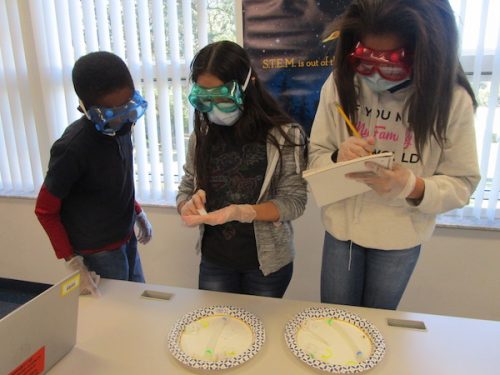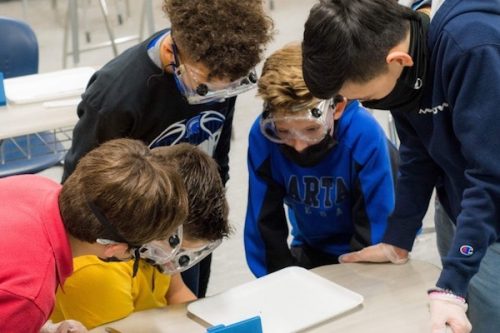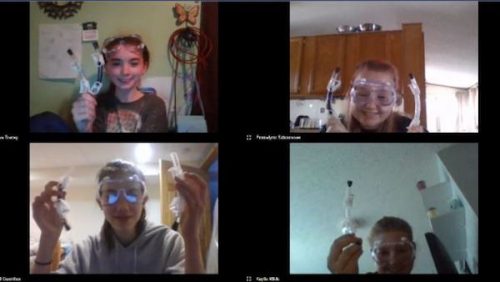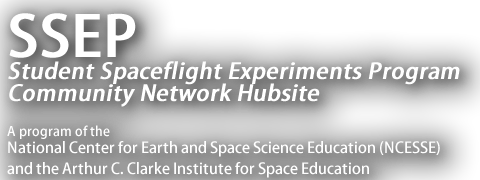The Student Spaceflight Experiments Program is proud to report that there were a total of 485 proposals submitted from student teams across the 5 communities participating in Mission 15 to ISS. Of those, 106 proposals were forwarded for review by Step 1 Review Boards in each of the communities. Each Step 1 Review Board selected up to three finalist proposals, which were submitted to the National SSEP Step 2 Review Board.
On December 11, 2020 the Step 2 Review Board met virtually and reviewed all 15 finalist proposals, and selected one proposed experiment to fly for the 5 participating communities, for a total of 5 flight experiments. By December 18, 2020, the National Center for Earth and Space Science Education and the Arthur C. Clarke Institute for Space Education formally notified each community of their selected flight experiments.
It is noteworthy that the 485 proposals received reflected a total of 1,719 grade 5-12 students fully engaged in experiment design.
All 15 finalist experiment teams, along with descriptions of their proposed flight experiments, are provided below. You are also invited to meet the SSEP Step 2 Review Board members for Mission 15 to ISS.
Congratulations to the over 1,700 students and their teachers participating in Student Spaceflight Experiments Program Mission 15 to the International Space Station.
Quickly Scroll to Individual Communities
- Moreno Valley, California
- Hillsborough County, Florida
- Bandera, Texas
- Burleson, Texas
- iForward-Grantsburg, Wisconsin
1. Moreno Valley, California
Jump to Moreno Valley’s Community Profile
SELECTED FOR FLIGHT:
The Effects of Microgravity on Passion Fruit Seeds
Grades 11-12, Valley View High School
Co-Principal Investigators: Savannah Boehnke, Itzia Gutierrez-Gutierrez
Investigator: Randy Haley
Teacher Facilitator: Stacy Katzenstein
Proposal Summary:
In this experiment Passion Fruit seeds also known as Passiflora edulis will be sent aboard the ISS for observation on how microgravity will affect the Passion Fruit seeds, this will be the on-orbit experiment. While the on-orbit experiment is going on, there will be a ground-truth experiment. The importance of studying the Passion Fruit is due to the fruit not being well known or studied a great deal, this experiment will bring new data out about the Passion Fruit. This experiment will last between 4-6 weeks. Once the experiment has concluded, both the ground-truth and on-orbit experiments will be examined and reviewed to reveal how
microgravity has affected the growth of the Passion Fruit seeds.
HONORABLE MENTION FINALISTS:
The Effects of Microgravity on the Germination of Caiman Tomato Seeds
Grade 12, Valley View High School
Principal Investigator: Kallydayali Aguirre
Teacher Facilitator: Stacy Katzenstein
Proposal Summary:
In this experiment I will study the effects of microgravity on Caiman tomato seeds. It would be interesting to see if microgravity creates any defects in tomatoes or if it creates any benefits. It is also good to know if tomatoes are able to grow in microgravity and if so how long it takes. If it does not grow we can see what was affected in the growth of the seed and how much it may have been able to grow.Seed germination is the beginning of the growth of a plant. As stated in “What is seed germination?” by Claudia F., when a seed germinates it grows roots and the shoots begin to appear. As Washa B. Washa explains in “Potential of the Dark as a Factor affecting Seed germination” factors that affect germination include temperature, oxygen or air, water or moisture, and sometimes light. When a seed begins to germinate it is then planted in soil so that it can continue to grow.
Effects of Microgravity on the Growth Rate of Germination of Carica Papaya Seeds
Grade 11, Valley View High School
Principal Investigator: Moises Lomeli
Teacher Facilitator: Stacy Katzenstein
Proposal Summary:
The proposed experiment will determine the effects that microgravity has on Carica Papaya
Seeds. Carica Papaya seeds will die at temperatures below freezing, but the seeds can withstand cold and hot weather, so the seeds can be safely transported to space. Carica Papaya seeds can be easily germinated by putting the seeds in a cool, moist environment. It is really beneficial to grow Carica Papaya seeds on the ISS. This is because the Carica Papaya fruit is highly nutritious and your body receives more beneficial nutrients from papayas than most fruits and vegetables. Also the Papaya leaf improves digestion by using a mineral that promotes a good digestive system as well as a special substance called papain. If Carica Papaya seeds are successful in their development, they can be a very good food source for astronauts in space, because you can get an abundance of them, by growing one, you can get up to 30 seeds or more, and then you can plant more. The fruit contains vitamins A, C, E, and vitamin B, like pantothenic acid including folate, and minerals such as magnesium and potassium, as well as food fibers. Researches have also shown that papaya seeds can also be used for helping to fight diseases, supporting kidney health, and protecting against cancer. When the experiment is completed, the findings will be evaluated by using cameras and rulers to measure seed sizes.
2. Hillsborough County, Florida
Jump to Hillsborough County’s Community Profile
SELECTED FOR FLIGHT:
The Effect of a Microgravity Environment on the Germination Rates and Growth Development of German Chamomile (Matricaria chamomilla) Seeds
Grade 5, Sheehy Elementary School
Principal Investigator: Katherine Artia-Veliz
Co-Investigators: Moses Donaldson, Brianda Obispo-Polanco
Teacher Facilitator: Dr. Nebi Salim Bakare

Sheehy Elementary students collecting and recording data to optimize their microgravity experiment exploring germination and growth rates of German chamomile (Matricaria chamomilla) seeds.
Proposal Summary:
The purpose of this investigation is to explore the effect of a microgravity environment on the germination rates and growth development of German Chamomile (Matricaria chamomilla) seeds. Conducting this experiment in a microgravity environment and on Earth at the same time will help us observe and compare how many seeds germinated, the growth rate of germinated seeds and the root development of germinated seeds. This research is important, because when astronauts grow their own crops, it reduces the need for resupply missions. In addition, previous NASA research has shown that growing gardens in the International Space Station (ISS) can help keep astronauts happy and healthy on long missions in space. Although a variety of fruits and vegetables have been grown on the ISS, there is limited published research about growing herbs. German Chamomile is a medicinal herb that can provide both mental and physical health benefits. Growing and caring for chamomile plants can be a form of recreation for the astronauts, which can reduce stress. German Chamomile produces daisy-like flowers that release a sweet apple-like scent that can be enjoyed by the astronauts. The flowers can also be used to make tea, produce essential oils and create herbal remedies for many health problems, such as depression, insomnia, pain, digestive problems and inflammation.
HONORABLE MENTION FINALISTS:
The Effects of Microgravity on the Budding of Hydra viridissima
Grade 7, Walker Middle Magnet School
Co-Principal Investigators: Brad Beenhakker, Rehan Dost, Samuel Fernandez, Rohan Halarnkar, Yassiel Mitchell, Luke Oldenburg
Collaborator: Gavin Flowers
Teacher Facilitator: Jodie Dukes
Proposal Summary:
The experiment the group is proposing will address the question “How does microgravity affect
the budding of Hydra viridissima?” As humanity explores the vast expanse of space, humans will be spending increased time in space instead of Earth. Though this provides humans with more information about the universe, time in space can take a toll on one’s health. Cosmic radiation is a problem that arises when humans spend time in space. Cosmic rays are high-energy particles originating from the Sun or outside the Solar System moving through space. Earth’s atmosphere protects humans from this radiation, but when humans are in space, exposure is higher due to less protection. Astronauts on the ISS usually receive 10x more radiation than on Earth. Therefore, radiation-induced organ damage will be hazardous when humans colonize celestial bodies. As organ donors become scarce in space, the need for regenerative therapies in space will become paramount. H. viridissima reproduces by budding, involving the use of the disruption of stem cells like the ones found in humans. When NASA sent human stem cells to the ISS, scientists found differences in the growth of them in microgravity. For this reason, there may be effects on Hydra reproduction while in microgravity. If the hypothesis is supported throughout this investigation, development of stem cells could be used to grow and repair human organs in space. Hydras are simple organisms without many specialized cells, which means that scientists can use this as a cornerstone of organ repair and development.
Cabbage in a Clutch
Grade 6, Randall Middle School
Co-Principal Investigators: Gabrielle Loney, Srishti Tripathi
Professional Advisor: Dr. Gioia Massa
Teacher Facilitator: Mary Vaughn
Proposal Summary:
This investigation will answer the question being proposed, “What is the frequency of germination of Chinese Cabbage, Chirimen Hakusai (Brassica Rapa) seeds?” This question fits the experiment because cabbage is a very healthy and nutritious vegetable. One of the reasons cabbage is the focus is, it has many benefits such as; being highin vitamins C and K, lowering the risk of heart disease and improving digestion. With the return of humans to the Moon in 2024 through the Artemis mission, astronauts will truly need a vital food source to survive on long-duration missions into deep space. Cabbage is an exceptional food and eaten by many cultures. Conducting this experiment in microgravity will allow for the team to be part of assisting with the research of growing crops in space. Brassica Rapa is an important crop to determine germination rates in space to not only add to the nutritional value but also for aesthetic and practical reasons. Growing plants in space reminds astronauts of being on Earth which enhances their psychological well-being. The experiment will consist of Formalin, which is used to preserve and stop the growth of the cabbage. This is necessary because we want the experiment to remain in the same growth phase as it is leaving the microgravity environment. This way the team will be able to accurately examine the cabbage after germinating in microgravity and compare the germination to the control experiment on Earth.
3. Bandera, Texas
Jump to Bandera’s Community Profile
SELECTED FOR FLIGHT:
The Effects of Microgravity on Lavender Germination
Grade 6, Bandera Middle School
Co-Principal Investigators: Eva Le, Abigail Sizemore, Sydney Moore, Brianna Moore, Lilyann Cox
Teacher Facilitator: Bette Koenig
Proposal Summary:
This experiment will determine the effect of microgravity on Lavender Germination. Lavender
plants reward with pretty gray-green leaves that include a refreshing scent (American Meadows,
2020). The criteria for the lavender plant to germinate would be the lavender seeds (1), alkaline soil (this soil has the most beneficial pH for the lavender plant), and water (over pour will lead to plant death; only needs to be watered once or twice a week). The seeds will approximately take 14 days (2 weeks) to germinate (Ellis, 2020). Lavender is often used in aromatherapy. The fragrance from the oils of the lavender plant is believed to help increase calmness and wellness (The Simple Things, 2019). Additionally, it has helped reduce stress, anxiety and possibly even mild pain. NASA indicates that one of the top 5 largest hazards facing human spaceflight is the effect of isolation on astronauts’ mental health, which lavender is a key remedy for (Mars, 2019).
HONORABLE MENTION FINALISTS:
Peppermint Seeds
Grade 7, Bandera Middle School
Co-Principal Investigators: Clayton Hollingsworth, Landon Munoz, Brylee Everett, Colton Rissmiller
Teacher Facilitator: Kathleen Foster
Proposal Summary:
The experiment being proposed is testing if the peppermint seeds will be able to germinate at a faster rate in microgravity, than here on Earth. Peppermint can have many health benefits such as reduction of bloating and indigestion (“Benefits of Peppermint Oil: Uses, Side Effects & Research”, 2020). It could also relieve migraines and hypertension due to the large amounts of menthol. The peppermint is also used for essential remedies and medicines to treat illnesses. It is also able to kill germs that lead to bad breath. Peppermint today is mainly used for flavoring tea, candies, ice cream, alcoholic beverages, chewing gum and other foods (“The 20 Most Useful Things You Can Do With Peppermint Oil”, 2020). The oil from peppermint can also be used to coat pipes to block any foul odors coming from the pipes. The hypothesis being conducted is whether or not the plant will grow faster and in better condition in microgravity than on Earth, or if it will not grow at all. If the peppermint seed is able to grow at a faster rate in microgravity, the astronauts on the International Space Station will be able to use and grow peppermint to aid in their health conditions at a faster rate. To analyze the results of this experiment, the peppermint seeds will be measured and examined with a microscope to notice any variations.
The Propagation of Chronic Wasting Disease in Microgravity
Grade 8, Bandera Middle School
Co-Principal Investigators: Kinlee Lawlis, Jazlyn Dickerson, Jalyn Lamb, Onna Shaw
Teacher Facilitator: Kathleen Foster
Proposal Summary:
The purpose of this experiment is to determine the proliferation rate of Chronic Wasting Disease, better known as CWD. Chronic Wasting Disease is a prion disease that affects members of the Cervidae family such as deer, elk, moose, and reindeer. It is commonly spread by bodily fluids such as saliva, blood, urine, and feces. Being a prion disease or transmissible spongiform encephalopathy, CWD is a progressive neurodegenerative disorder that is fatal and typically results in drastic weight loss (wasting), listlessness, stumbling and other neurological symptoms. CWD has not only become more prominent in our small county of Bandera but in countries all across the world. As stated by the Centers for Disease Control and Prevention (CDC), “As of August 2020, there were 315 counties in 24 states with reported CWD in free-ranging cervids.” This count does not include the number of captive cervids with Chronic Wasting Disease, nor does it include the amount of Cervidae members that have the disease and have not yet been tested/counted for. Of course CWD doesn’t only affect deer and elk; it also affects us humans economically and physically. For example, if members of the cervidae family continue to have a high mortality rate because of CWD this could lead ranchers and game hunters to stop buying corn/deer feed, ammo, game feeders and firearms from outdoor and wildlife stores since the animals they are hunting or feeding are just disappearing. This horrific disease affects us physically because if an infected animal happens to stumble onto a highway it would most likely cause a crash or wreck which could even lead to death for the animal and victims involved. In bringing this malignant disease to space the group hopes to see a decrease in the proliferation rate that will not only lead to a cure, but benefit both cervidae members and humans globally!
4. Burleson, Texas
Jump to Burleson’s Community Profile
SELECTED FOR FLIGHT:
The Effect of Microgravity on Cellular Regeneration of the Planarian Flatworm
Grade 6, Nick Kerr Middle School
Co-Principal Investigators: Camden Morton, Santiago Rios Ordonez, Levi Robinson, Miguel Ruiz, Brian Smith
Teacher Facilitator: Jonathan Hawley-Bernardez

Student researchers ( left to right) Brian Smith, Santiago Rios Ordonez, Levi Robinson, Camden Morton, and Miguel Ruiz practice dissection skills on Planarian flatworms. They will be looking for growth differences between their ground truth and flight experiments.
Proposal Summary:
We are planning to do an experiment where we send an FME tube with planarian flatworms and formaldehyde inside the space station in microgravity to see if it affects the planarian worms’ regeneration process. First we will cut the worms’ heads off on Earth, then refrigerate the worms at 4 degrees so they go into hibernation and the stem cells, which are how the planarian flatworms regenerate, don’t start the regeneration process. Our hypothesis is that since in microgravity there is a lessened force of gravity, it will let the planarian worms regenerate more freely, which means they will grow larger. The force of gravity on Earth is more powerful, so it will pull harder on the planarian flatworms, reducing their regeneration. In conclusion, we will be able to see the effects that microgravity has on the regeneration process of the planarian worms.
HONORABLE MENTION FINALISTS:
Brandywine Tomato
Grade 6, Hughes Middle School
Co-Principal Investigators: Morgan McAlpin
Co-Investigators: Nevaeh Nunez
Collaborator: Kierah Virgil
Teacher Facilitator: Jonathon Smith
Proposal Summary:
Astronauts need vitamins, minerals, and antioxidants in order to maintain health in space. The researchers believe that the Brandywine tomato grown inside of sandy loam will provide Vitamin, C, Vitamin D, Folate, Potassium and the antioxidant Lycopene when grown for the benefit of space travel. The bare bones of our experiment will include adding water to the mixture of sandy loam and tomato seeds. If successful, the researchers will see better growth of the Brandywine tomato in microgravity. The researchers will make a direct comparison to the growth of the seedlings in microgravity to those seedlings grown in gravity. There have been many successful experiments using tomatoes and this team would like to verify them as well as add to the research with this soil variety.
Lima Bean
Grade 6, Hughes Middle School
Co-Principal Investigators: Rylie Cline, Kaydan Sorman, Morgan Guidry, Peyton Martin, Nicholas Munoz
Teacher Facilitator: Holly Adams
Proposal Summary:
In the future, astronauts have a chance to go to Mars. When that happens, they will need a good food source to sustain them. Lima beans are a superfood that is nutritious and delicious. This experiment will test the germination rate of lima bean seeds in microgravity, to see if they will germinate at the same or faster rate than on Earth. When the germinated seed returns from the ISS, it will be observed and the radicle, hypocotyl, and cotyledon will be measured. Those measurements will be compared to the ground truth experiment to determine rate of growth. The hypothesis is that the lima bean will germinate faster or at the same rate in microgravity as it does on Earth, making it a reliable food choice in space. This experiment provides the opportunity to provide nutritious food sources for future space travelers and possibly one day colonists on Mars.
5. iForward-Grantsburg, Wisconsin
Jump to iFoward-Grantsburg’s Community Profile
SELECTED FOR FLIGHT:
If Grape Seeds were in Microgravity, Would they still be able to Germinate?
Grade 7, iForward Public Online Charter School
Co-Principal Investigators: Jill Guenther, Kaylie Mikle, Emmalynn Schoonover, Ava Tracey
Professional Advisors: Amaya Atucha, Kendra Awe, Dr. Kevin Crosby, Jena Winder
Teacher Facilitator: Andrea Konrath

The student flight team comparing Mission 15 trial results virtually at the iForward Online School, Wisconsin.
Proposal Summary:
In this project, the investigators hope to germinate concord grapes, or Vitis labrusca, in microgravity. Astronauts often have weak bones after going into space for long flights. According to a NASA article, “Many scientists believe that microgravity somehow causes bone to break down at a much faster rate than it is built up” (Dunbar). This is a major health concern. An astronaut’s bones might get so fragile that they could fracture. Vitis labrusca provide many nutrients that are good for bone health, such as calcium, magnesium, phosphorus and more. If this project is successful, grapes could be grown in space and provide many nutrients to help with the health of astronauts. The investigators’ hypothesis is, the grape seeds will germinate slower in microgravity than on Earth because the seeds will be without gravity and sunlight.
HONORABLE MENTION FINALISTS:
The Effect of Microgravity on the Levels of Prussic Acid in Sweet Almonds
Grade 9, iForward Public Online Charter School
Co-Principal Investigators: Sarha Baker, Miriam Freeman, Grace Mullikin, Emma Ottens
Professional Advisors: Jennifer Jawoorski, Laura Kavajecz, Jena Winder
Teacher Facilitator: Mark Dilley
Proposal Summary:
This experiment seeks to evaluate the prussic acid levels in crushed sweet almonds (in microgravity). By analyzing this experiment, scientists will be able to determine if using
almonds in space for gluten replacement will still be beneficial to the human body for all people, but especially those with gluten intolerance. From milk to extract, almonds have been used for years to help overcome the difficulties with allergies and intolerances. However, almonds contain a small amount of cyanide with each consumed dosage of almonds. Because of this, almonds could be potentially dangerous in space if microgravity affects their toxicity. If the levels rise, then it may be beneficial to find a new replacement for almonds altogether for people with gluten intolerance, or foods containing almonds. Cyanide, or prussic acid, in almonds, will need a special system for testing its levels. To evaluate the results of the experiment, the system of gas chromatography will be used to analyze the levels of prussic acid after the almonds return to Earth. By using gas chromatography, it should be quite simple to get accurate results within a reasonable amount of time. This experiment could be revolutionary if the levels of prussic acid rise, since they would no longer be useful because of their toxicity in microgravity. However, if this experiment is successful with no rising in the levels, then it could open many doors to those who wish to be astronauts, but currently cannot due to their gluten intolerance.
Microgravity: Vinegar’s Effect on Copper
Grade 8, iForward Public Online Charter School
Co-Principal Investigators: Malachi Alphonse, Laura Bartels, Wyatt Green, Gabriella Hamlin, Zachary Lierman, Victoria Sparks
Professional Advisors: Courtney Clyde, Jena Winder
Teacher Facilitator: Ryan Walsh
Proposal Summary:
Our proposal is to look at how vinegar will clean and affect copper in microgravity. To make
sure that the experiments are the same, the same experiment will take place on Earth, duplicating the experiment as in microgravity. This experiment could be incredibly beneficial to the advancement of electricity in space, and it would help humanities ability to make repairs and recycle old parts. Because many wires and parts in spaceships are made of copper, there needs to be an efficient way to clean them. It is expected that the coppers cleaning process will be sped up in microgravity. Contact with air causes copper to tarnish or create a layer of copper oxide. Since vinegar can dissolve this layer with gravity, it is suspected this process will be sped up in microgravity. The investigation will demonstrate whether the chemical reaction between the copper and vinegar will happen faster due to the of gravity.
